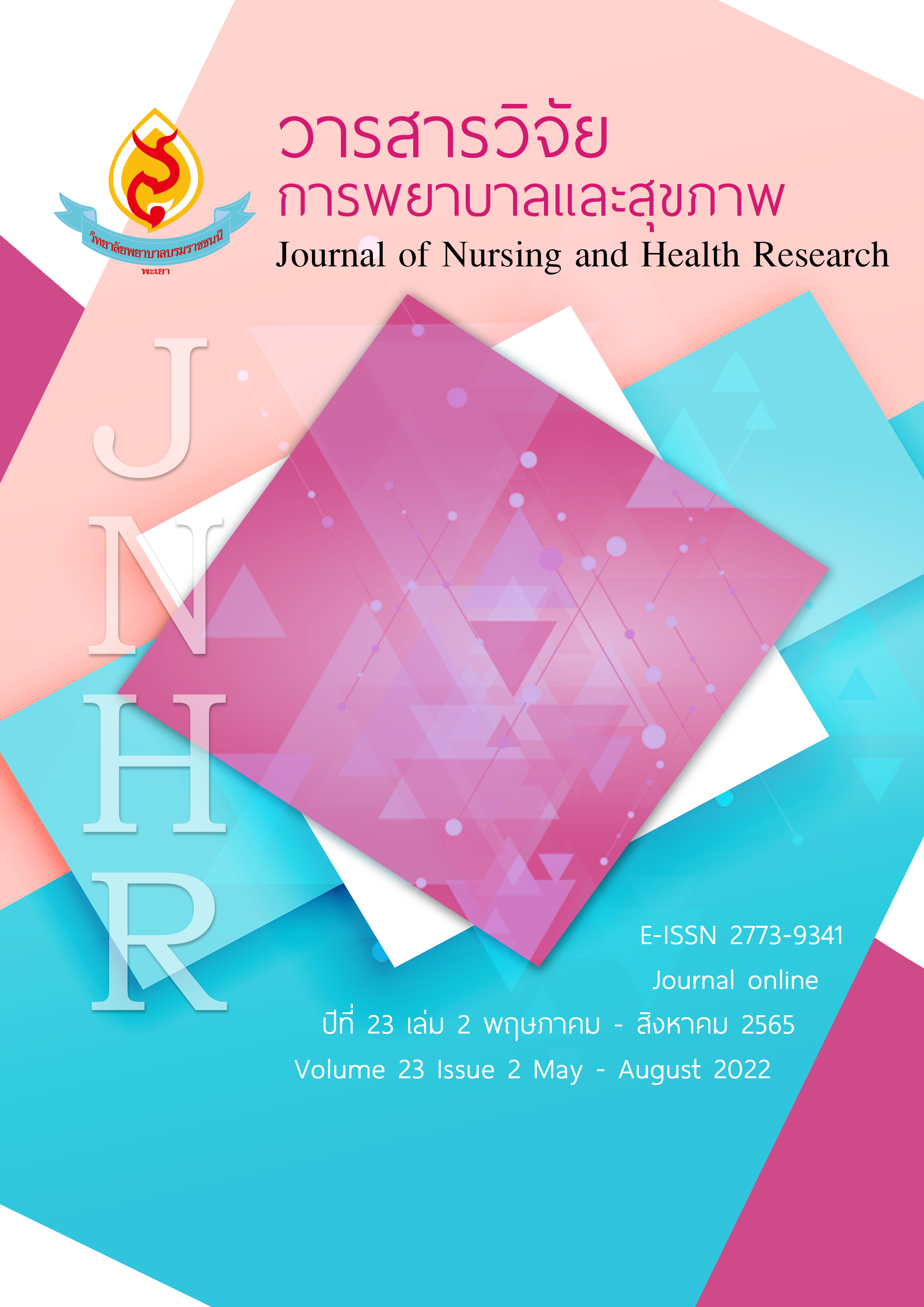การพัฒนารูปแบบการพยาบาลผู้ป่วยที่มีภาวะติดเชื้อในกระแสโลหิต โรงพยาบาลพะเยา
คำสำคัญ:
รูปแบบการพยาบาล, การติดเชื้อในกระแสโลหิต, ภาวะซ็อคจากการติดเชื้อบทคัดย่อ
การวิจัยและพัฒนานี้มีวัตถุประสงค์เพื่อพัฒนารูปแบบการพยาบาลผู้ป่วยที่มีภาวะติดเชื้อในกระแสโลหิต โรงพยาบาลพะเยา และศึกษาผลลัพธ์ที่เกิดขึ้น แบ่งเป็น 4 ระยะ ได้แก่ 1) ระยะศึกษาสถานการณ์ โดยการสัมภาษณ์เชิงลึก และสัมภาษณ์กลุ่มในกลุ่มพยาบาลวิชาชีพ 2) ระยะพัฒนารูปแบบ 3) ระยะนำรูปแบบ ไปทดลองใช้เป็นเวลา
6 เดือน และ 4) ระยะประเมินผลลัพธ์ของรูปแบบ กลุ่มตัวอย่างประกอบด้วยเวชระเบียนประวัติผู้ป่วยจำนวน 180 ราย
และพยาบาลวิชาชีพ จำนวน 79 ราย เก็บข้อมูลระหว่างเดือนกุมภาพันธ์ 2564-กุมภาพันธ์ 2565 เครื่องมือที่ใช้ประกอบด้วย 1) แบบประเมินความรู้ของพยาบาลในการดูแลผู้ป่วยที่มีภาวะติดเชื้อในกระแสโลหิต มีค่าดัชนี
ความยากง่าย เท่ากับ .65 และค่าอำนาจจำแนก เท่ากับ .28 2) แบบประเมินการปฏิบัติตามแนวปฏิบัติการพยาบาล ก่อนและหลังการประชุมเชิงปฏิบัติการ 3) แบบประเมินความเป็นไปได้และความพึงพอใจของพยาบาลต่อรูปแบบฯ
มีค่าสัมประสิทธิ์ความเชื่อมั่นของครอนบาคแอลฟ่า เท่ากับ .80 และ 4) แบบบันทึกข้อมูลผู้ป่วย วิเคราะห์ข้อมูลโดยใช้สถิติเชิงพรรณนา วิเคราะห์อัตราการรอดชีพ ด้วยวิธี Kaplan-Meier survival estimates วิเคราะห์ผลการพัฒนารูปแบบการพยาบาลผู้ป่วยที่มีภาวะติดเชื้อในกระแสโลหิตด้วยสถิติ Cox regression และการวิเคราะห์ข้อมูลเชิงคุณภาพ
ใช้การวิเคราะห์เนื้อหา ผลการวิจัย หลังการพัฒนารูปแบบฯ พบว่า 1) ได้รูปแบบการพยาบาลผู้ป่วยที่มีภาวะติดเชื้อ
ในกระแสเลือด โรงพยาบาลพะเยาที่สามารถนำไปใช้กับผู้ป่วยได้ 2) กลุ่มตัวอย่างได้รับการประเมินโดยใช้เกณฑ์สัญญาณเตือนภัยก่อนเข้าสู่ภาวะวิกฤติ แตกต่างจากกลุ่มตัวอย่างก่อนการพัฒนารูปแบบ อย่างมีนัยสำคัญทางสถิติ (p<.05) 3) กลุ่มตัวอย่างได้รับการเจาะเลือดเพาะเชื้อก่อนให้ยาปฏิชีวนะ ได้รับยาปฏิชีวนะภายใน 1 ชั่วโมง ได้รับสารน้ำ
ทางหลอดเลือดดำภายใน 1 ชั่วโมง และมีอัตรารอดชีวิตภายใน 7 วัน แตกต่างจากกลุ่มตัวอย่างก่อนการพัฒนารูปแบบ
อย่างมีนัยสำคัญทางสถิติ (p<.05) และ 4) กลุ่มตัวอย่าง เพิ่มอัตรารอดชีพใน 7 วันแรกที่เข้ารับการรักษา ร้อยละ 56 เมื่อเทียบกับการได้รับการพยาบาลตามมาตรฐานเดิม (95% CI 0.02-0.96) (p<.05) รูปแบบการพยาบาลฯ นี้สามารถนำไปปรับใช้ในการพยาบาลผู้ป่วยที่มีภาวะติดเชื้อในกระแสโลหิตของโรงพยาบาลทั่วไปสอดคล้องตามมาตรฐานการดูแลของวิชาชีพพยาบาล
เอกสารอ้างอิง
นิตยา ภูริพันธุ์, อำนาจ กาศสกุล, และ ณัฐวรรณ พละวุฑิโฒทัย. (2563). ผลลัพธ์ของการพัฒนาการใช้ sepsis protocol checklist lerdsin hospital. วารสารวิจัยสุขภาพและการพยาบาล. 36(1), 12-21
ลัลธริตา เจริญพงษ์. (2563). อุบัติการณ์และปัจจัยเสี่ยงที่มีผลต่อการเสียชีวิตของผู้ป่วยติดเชื้อในกระแสโลหิตที่รับไว้รักษาในโรงพยาบาลเจ้าพระยายมราช. วารสารแพทย์เขต 4-5, 39(4), 542-560.
วิไลวรรณ เนื่อง ณ สุวรรณ, จิราพร นอมกุศล, รัตนา ทองแจม, และธนชัย พนาพุฒิ. (2557). การพัฒนาระบบการพยาบาลผูปวยที่มีภาวะติดเชื้อในกระแสเลือดอยางรุนแรง.วารสารการพยาบาลและการดูแลสุขภาพ, 32(2), 25-36.
สมไสว อินทะชุบ, ดวงพร โพธิ์ศรี, และ จิราภรณ์ สุวรรณศรี. (2560). ประสิทธิผลการใช้ MEWS (SOS score) ต่อการเกิด severe sepsis and septic shock ในผู้ป่วย sepsis กลุ่มงานอายุรกรรมโรงพยาบาลอุดรธานี. วารสารการแพทย์โรงพยาบาลอุดรธานี, 25(1), 85-92.
โรงพยาบาลพะเยา. (2563). รายงานประจำปีโรงพยาบาลพะเยา 2561-2563. พะเยา: โรงพยาบาลพะเยา
โรงพยาบาลพะเยา. (2562) การประชุมคณะกรรมการsepsis โรงพยาบาลพะเยา 2562. พะเยา: โรงพยาบาลพะเยา
อ่อนน้อม ธูปะวิโรจน์. (2557). ผลของการวางแผนจำหน่ายและการติดตามทางโทรศัพท์ต่อระดับฮีโมโกลบินที่มีน้ำตาลเกาะ ความพึงพอใจในการบริการของผู้ป่วยเบาหวาน และความพึงพอใจในงานของพยาบาล. วารสารสมาคมเวชศาสตร์ป้องกันแห่งประเทศไทย, 4(2), 151-161.
อัมราภัสร์ อรรถชัยวัจน์, ธีรพร สถิรอังกูร, นวลขนิษฐ์ ลิขิตลือชา, และ อรุณี ไพศาลพาณิชย์กุล. (2561). บทบาทหน้าที่ของพยาบาลวิชาชีพ. สืบค้น กันยายน 2564, จากhttp://nurse.npru.ac.th/system/20190113191522_a0a9ca0b2dc8a20555739e94e6ab03dc.pdf
Angus, D.C & Poll T. V. D. (2013). Severe sepsis and septic shock. The New England Journal of Medicine, 369(9), 840-851.
Bernard, R. (2000). Fundamentals of biostatistics (5th ed.). Duxbery: Thomson learning. 384-385.
Bloom, B.S, Hasting, J.T, & Madaus, G.F. (Eds.). (1971). Handbook on formative and summative evaluation of student learning. New York: McGraw-Hill Book Co.
Bentley, J. A., Henderson, S., Thakore, S., Donald, M., & Wang, W. (2016). Seeking sepsis in the emergency department-identifying barriers to delivery of the sepsis 6. BMJ Quality Improvement Reports 5(1), u206760.w3983. doi:10.1136/bmjquality.u206760.w3983
DASHBOARD KPI Ministry of Public Health Statistic. (2020). Mortality rate in community acquired sepsis. Health Data Center: HDC. Retrieved September 16, 2019,from https//healthkpi.morphh.go.th./kpi2/kpi-list/view/?id=1448
Jason, H.M., David, F.G., & Mark. E.M. (2015). Early Recognition: the rate-limiting step to quality care for severe sepsis patients in the emergency epartment. Journal of Clinical Outcomes Management. 22(5), 211-221.
Levy, M.M., Evans, L.E. & Rhodes, A. (2018). The surviving sepsis campaign bundle: 2018 update. Intensive Care Med, 44(925-928). doi: 10.1007/s00134-018-5085-0
Mathukia, C., Fan, W., Vadyak, K., Biege, C., & Krishnamurthy, M. (2015). Modified early warning system improves patient safety and clinical outcomes in an academic community hospital. Journal of Community Hospital Internal Medicine Perspectives, 5(2), 26716. doi: 10.3402/jchimp.v5.26716
Rivers, E., Nguyen, B., Havstad, S., Ressler, J., Muzzin, A., Knoblich, B., … the Early Goal-Directed Therapy Collaborative Group. (2001). Early goal-directed therapy in the treatment of severe sepsis and septic shock. The New England Journal of Medicine, 345(19), 1368-1377. doi: 10.1056/NEJMoa010307
Singer, M., Deutschman, C.S., Seymour, C.W., Shankar-Hari, M., Annane, D., Bauer, M., …, Angus, D. C. (2016). The third international consensus definitions for sepsis and septic shock (Sepsis-3). JAMA, 315(8), 801-810. doi:10.1001/jama.2016.0287
Sullivan TJ. (1998). Collaboration: A Health Care Imperative. New York, NY: McGraw Hill .
Wang, A. Y., Fang, C. C., Chen, S. C., Tsai, S. H., & Kao, W. F. (2016). Periarrest modified early warning score (MEWS) predicts the outcome of in-hospital cardiac arrest. Journal of the Formosan Medical Association=Taiwan yi zhi, 115(2), 76–82. doi:10.1016/j.jfma.2015.10.016
Yousefi, H., Nahidian, M., & Sabouhi, F. (2012). Reviewing the effects of an educational program about sepsis care on knowledge, attitude, and practice of nurses in intensive care units. Iranian Journal of Nursing and Midwifery research, 17(2 Suppl 1), S91–S95.
ดาวน์โหลด
เผยแพร่แล้ว
รูปแบบการอ้างอิง
ฉบับ
ประเภทบทความ
สัญญาอนุญาต
ลิขสิทธิ์ (c) 2022 วารสารวิจัยการพยาบาลและสุขภาพ

อนุญาตภายใต้เงื่อนไข Creative Commons Attribution-NonCommercial-NoDerivatives 4.0 International License.



